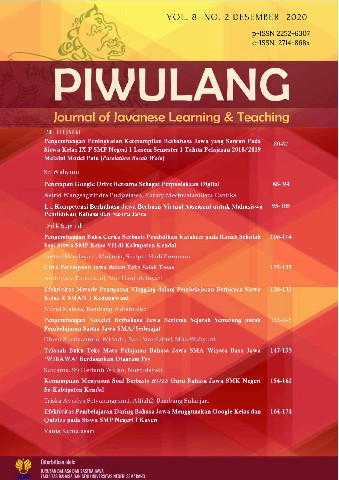Pengembangan Novelet Berbahasa Jawa Bertema Sejarah Semarang untuk Pembelajaran Sastra Jawa SMA/Sederajat
##plugins.themes.academic_pro.article.main##
Abstract
The existence of Javanese novels in Javanese literature learning has a standard thickness of novels (more than 100 pages) with various themes. Not all novels that have been published can be used as study material in literature learning. Literary works that can be used as teaching material with the theme of Semarang history. There are various values ​​of life that can be learned, such as religion and tolerance, openness, and discipline, and hard work. There are two main objectives of the research, namely (1) the characteristics of the needs of teachers and students and (2) the draft novelet in Javanese with the theme of Semarang history. This development research was carried out with a research and development (R&D) design developed by Borg and Gall (2003) and modified into two stages, namely (1) preliminary studies and (2) draft development. The characteristics of the needs of teachers and students are seen from the four aspects of book feasibility, namely material, language, presentation, and graphics. The novelet draft consists of the beginning, the content, and the end. The initial section consists of the title page, the publication page, the table of contents page, and the foreword page. The contents of the novelet draft consisted of four short novels with historical themes in the city of Semarang, such as Ki Ageng Pandanaran, Admiral Cheng Ho, the legend of Gua Kreo, and the Five Days Battle in Semarang. The final section contains the author's biography.
##plugins.themes.academic_pro.article.details##
References
Azizah, N. (2013). Pengembangan Buku Bacaan Cerita Rakyat Bahasa Jawa Berbasis Kontekstual di Kabupaten Brebes. Skripsi Pendidikan Bahasa dan Sastra Jawa, Universitas Negeri Semarang.
Borg, W. R., & Gall, M. D. (2003). Educational esearch: an Introduction (7. Ed). New York: Gogman Inc.
Darwis, M. (2011). Nasib Bahasa Daerah di Era Globalisasi: Peluang dan Tantangan. Workshop Pelestarian Bahasa Daerah Bugis Makassar (pp. 1-13). Makassar: Balitbang Agama Makassar.
Dimova, V. (2011). Education and Culture. Procedia - Social and Behavioral Sciences, 15, 2357-2359. doi: https://doi.org/10.1016/j.sbspro.2011.04.107.
Depdiknas. (2006). Pedoman Memilih dan Menyusun Bahan Ajar. Jakarta: Depdiknas.
Jalilehvand, M. (2012). The Effects of Teks Lenght and Picture on Reading Comprehension of Iranian EFL Student. Canadian Center of Science and Education, 8 (3), 329-337. doi: 10.5539/ass.v8n3p329.
Khakim, N. F. (2016). Telaah Penulisan Karya Sastra Sejarah sebagai Refleksi Sumber Pembelajaran Sejarah. Jurnal Sejarah dan Budaya, 10(1), 89-94. doi: http://dx.doi.org/10.17977/sb.v10i1.5922
Kurniawati, N. E., & Agus, N. (2016). “Pengembangan Bahan Ajar Membaca Novel Berbahasa Jawa Melalui Simplifikasiâ€. Seloka: Jurnal Pendidikan Bahasa dan Sastra Indonesia, 5(1), 216-224. https://journal.unnes.ac.id/sju/index.php/seloka/article/view/12750.
Nurgiyantoro, Burhan. (2019). Teori Pengkajian Fiksi. Yogyakarta: UGM Press.
Nurhayati, Enung. (2019). Cipta Kreatif Karya Sastra. Bandung: Yrama Widya.
Octaviani, L. (2015). Pandatara dan Jarlatsuh: Model Pendidikan Multikltural di SMA Taruna Nusantara Magelang. Jurnal Komunitas, 5(1), 112-127. doi: https://doi.org/10.15294/komunitas.v5i1.2383
Parrish, Patrick and Jennifer A. Linder Van Berschot. (2010). Cultural Dimensions of Learbing: Addressing the Challenges of Multicultural Intruction. Journal Science Teacher Education, 11(2), 1-19. doi: 10.19173/irrodl.v11i2.809.
Purba, A. (2012). Sastra Indonesia Kontemporer. Yogyakarta: Graha Ilmu.
Sehandi, Y. (2014). Mengenal 25 Teori Sastra. Yogyakarta: Ombak.
Soekmono, R. (2017). Pendidikan Multikultural Melalui Program Bahasa Holistik (Penelitian Pengembangan di Kelompok B Taman Kanak-Kanak Nasima Semarang). JPUD – Jurnal Pendidikan Usia Dini, 11(2), 302-322. doi: https://doi.org/10.21009/JPUD.112.09.
Susetyo, B & Edy, W. (2015). Pengalaman Multikultural Warga Etnis Cina di Semarang. Prosiding Diskusi Prikologi Sosial – Quo Vadis Konflik Sosial di Indonesia. https://d1wqtxts1xzle7.cloudfront.net/54637841/Pengalaman_Multikultural_Warga_Etnis_Cina_di_Semarang.pdf.
Syarifa, L. L., Agus, N., & Subyantoro. (2015). Pengembangan Buku Pengayaan Teknik Memproduksi Teks Cerita Ulang yang Bermuatan Kearifan Lokal bagi Peserta Didik Kelas XI SMA. Seloka : Jurnal Pendidikan Bahasa dan Sastra Indonesia, 4(2), 102–110. https://journal.unnes.ac.id/sju/index.php/seloka/article/view/9867
Triyanto. 2018. Belajar dari Kearifan Lokal Seni Pesisiran. Semarang: Cipta Prima Nusantara.
